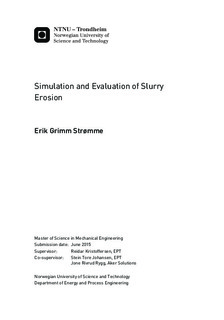Simulation and Evaluation of Slurry Erosion
Abstract
Erosion from sand particles is a large problem in piping systems, especially in the oil and gas industries. Different types of erosion occur depending on the concentration of particles present in the fluid. Computational Fluid Dynamics (CFD) is a promising tool for erosion prediction, with different models available for erosion calculations. The most commonly studied erosion models are the Lagrangian impact based. These are simplified models, and puts a limit to model flows where particle concentrations increases.
The aim for this master s thesis has been to investigate and assess available models in ANSYS Fluent for evaluating slurry erosion rates.
First, a literature study was carried out in order to understand how slurry flows behave under different flow conditions, how erosion from different sand particle concentrations are modelled and which models that are available ANSYS Fluent for these calculations. An important part of the study was to find available experimental results regarding erosion rates in literature, which could be replicated into CFD as validation of the erosion models. The Lagrangian Discrete Phase Model (DPM) approach was used to validate the DNV erosion model against an experimental case with low particle concentration. A Slurry flow case simulation with the Eulerian model with a Dense Discrete Phase Model (DDPM) was set up on the same case in order to see if the model could capture the abrasive wear from the particles. All results from the DPM and DDPM simulations were written to file, plotted and compared with experimental results. Attempts were made in order to include the Discrete Element Method (DEM) collision model into the erosion simulations.
It was found that the DNV impact based erosion model shows good agreement with the experimental result by capturing the location and magnitudes of erosion rate. When including the Eulerian DDPM on the same geometry, results did not change much on the low particle concentration case. Thus, abrasive wear became more dominant as the particle concentration increased which is because of the increase of the wall shear stress from the slurry flow.
Since no suitable cases were found in literature regarding slurry erosion rates, an experimental case with higher particle concentrations should be performed so the models for slurry erosion can be validated.
